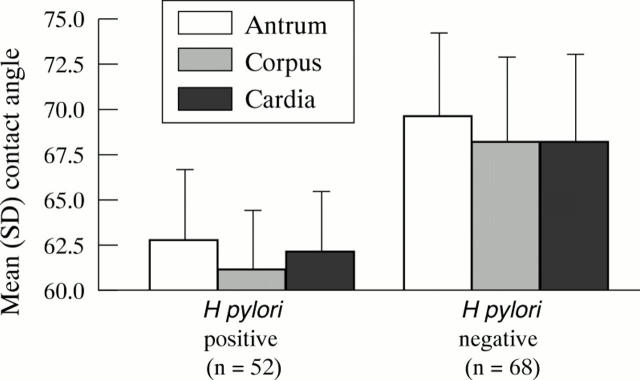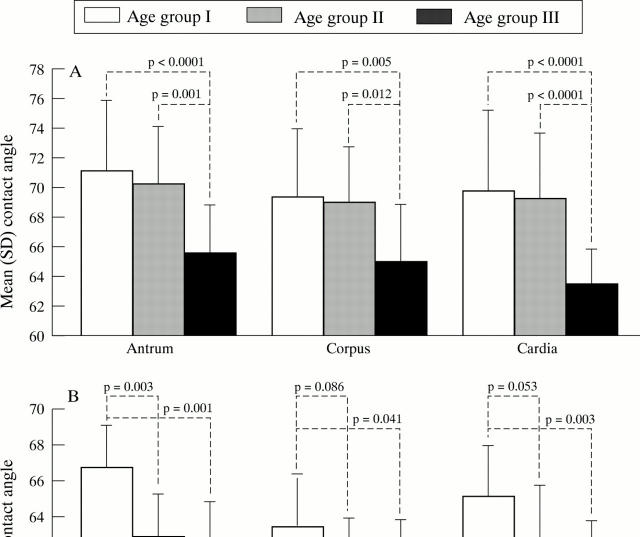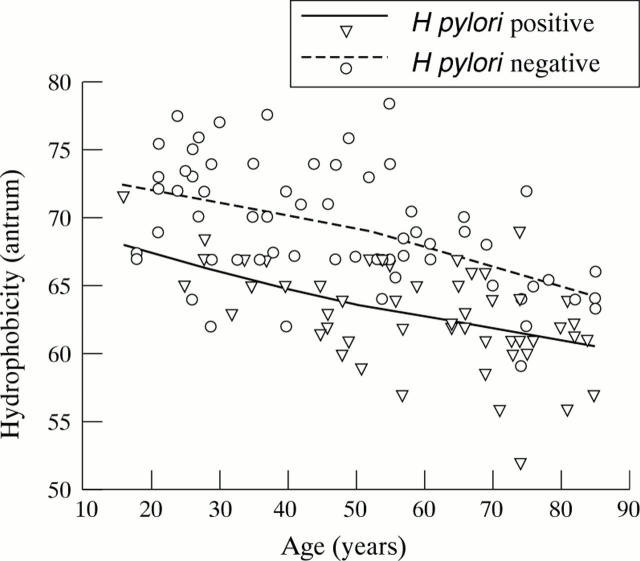Abstract
Background—Gastric mucosal surface hydrophobicity (GMSH) is an essential component of the mucosal defence system that is decreased by Helicobacter pylori and non-steroidal anti-inflammatory drugs (NSAIDs). Gastric ulcers occur predominantly in elderly subjects, and may thus reflect diminished mucosal resistance. Aims—To investigate whether aging decreases GMSH. Patients—One hundred and twenty patients without peptic ulcer disease were divided into three age groups: I (41 years or below); II (41-64 years); and III (65 years or above). Methods—Biopsy specimens were taken from the antrum, corpus, and cardia for histology (Sydney system), urease testing for H pylori, and for contact angle measurement of GMSH with a goniometer. The presence of specific H pylori antibodies was checked by immunoblotting. Results—Fifty two patients (43%) were infected, and 68 were uninfected with H pylori. GMSH at all biopsy sites was lower in H pylori infected subjects (p=0.0001), but also decreased with age independently of infection status (p=0.0001). The most notable decrease in GMSH occurred between age groups I and II in those with, and between age groups II and III in those without, H pylori infection. GMSH was greater in antral than in corpus mucosa in both infected (p=0.0001) and uninfected patients (p=0.0003). Conclusions—A physiological decrease in GMSH with aging may contribute to the risk of ulcer development in the elderly, and may act synergistically with H pylori and/or NSAIDs on gastric mucosal defence.
Keywords: gastric mucosal defence; surface hydrophobicity; aging; Helicobacter pylori
Full Text
The Full Text of this article is available as a PDF (125.1 KB).
Figure 1 .
Means of contact angles as a function of H pylori status and biopsy site.
Figure 2 .
(A) Mean contact angles (SD) at the three biopsy sites in patients without H pylori infection as a function of age. Group I (n=31), Group II (n=23), Group III (n=14). (B) Mean contact angles (SD) at the three biopsy sites in patients with H pylori infection as a function of age. Group I (n=9), Group II (n=17), Group III (n=26).
Figure 3 .
Contact angle values as a measure of GMSH in antral mucosa according to age and H pylori infection.
Selected References
These references are in PubMed. This may not be the complete list of references from this article.
- Asante M., Ahmed H., Patel P., Davis T., Finlayson C., Mendall M., Northfield T. Gastric mucosal hydrophobicity in duodenal ulceration: role of Helicobacter pylori infection density and mucus lipids. Gastroenterology. 1997 Aug;113(2):449–454. doi: 10.1053/gast.1997.v113.pm9247463. [DOI] [PubMed] [Google Scholar]
- Bernhard W., Schulte H., Piller M., Sewing K. F. Synthesis and release of phosphatidylcholine by isolated porcine gastric mucous cells in primary culture. Eur J Clin Invest. 1996 Sep;26(9):797–802. doi: 10.1046/j.1365-2362.1996.2100556.x. [DOI] [PubMed] [Google Scholar]
- Cullen D. J., Collins B. J., Christiansen K. J., Epis J., Warren J. R., Surveyor I., Cullen K. J. When is Helicobacter pylori infection acquired? Gut. 1993 Dec;34(12):1681–1682. doi: 10.1136/gut.34.12.1681. [DOI] [PMC free article] [PubMed] [Google Scholar]
- Dial E. J., Lichtenberger L. M. A role for milk phospholipids in protection against gastric acid. Studies in adult and suckling rats. Gastroenterology. 1984 Aug;87(2):379–385. [PubMed] [Google Scholar]
- Dial E. J., Lichtenberger L. M. Milk protection against experimental ulcerogenesis in rats. Dig Dis Sci. 1987 Oct;32(10):1145–1150. doi: 10.1007/BF01300202. [DOI] [PubMed] [Google Scholar]
- Dial E. J., Lichtenberger L. M. Surface hydrophobicity of the gastric mucosa in the developing rat. Effects of corticosteroids, thyroxine, and prostaglandin E2. Gastroenterology. 1988 Jan;94(1):57–61. doi: 10.1016/0016-5085(88)90609-9. [DOI] [PubMed] [Google Scholar]
- Dixon M. F., Genta R. M., Yardley J. H., Correa P. Classification and grading of gastritis. The updated Sydney System. International Workshop on the Histopathology of Gastritis, Houston 1994. Am J Surg Pathol. 1996 Oct;20(10):1161–1181. doi: 10.1097/00000478-199610000-00001. [DOI] [PubMed] [Google Scholar]
- Farinati F., Formentini S., Della Libera G., Valiante F., Fanton M. C., Di Mario F., Vianello F., Pilotto A., Naccarato R. Changes in parietal and mucous cell mass in the gastric mucosa of normal subjects with age: a morphometric study. Gerontology. 1993;39(3):146–151. doi: 10.1159/000213526. [DOI] [PubMed] [Google Scholar]
- Gabriel S. E., Jaakkimainen L., Bombardier C. Risk for serious gastrointestinal complications related to use of nonsteroidal anti-inflammatory drugs. A meta-analysis. Ann Intern Med. 1991 Nov 15;115(10):787–796. doi: 10.7326/0003-4819-115-10-787. [DOI] [PubMed] [Google Scholar]
- Goddard P. J., Hills B. A., Lichtenberger L. M. Does aspirin damage canine gastric mucosa by reducing its surface hydrophobicity? Am J Physiol. 1987 Mar;252(3 Pt 1):G421–G430. doi: 10.1152/ajpgi.1987.252.3.G421. [DOI] [PubMed] [Google Scholar]
- Goddard P. J., Kao Y. C., Lichtenberger L. M. Luminal surface hydrophobicity of canine gastric mucosa is dependent on a surface mucous gel. Gastroenterology. 1990 Feb;98(2):361–370. doi: 10.1016/0016-5085(90)90826-m. [DOI] [PubMed] [Google Scholar]
- Goggin P. M., Marrero J. M., Spychal R. T., Jackson P. A., Corbishley C. M., Northfield T. C. Surface hydrophobicity of gastric mucosa in Helicobacter pylori infection: effect of clearance and eradication. Gastroenterology. 1992 Nov;103(5):1486–1490. doi: 10.1016/0016-5085(92)91168-4. [DOI] [PubMed] [Google Scholar]
- Goto H., Sugiyama S., Ohara A., Hoshino H., Hamajima E., Kanamori S., Tsukamoto Y., Ozawa T. Age-associated decreases in prostaglandin contents in human gastric mucosa. Biochem Biophys Res Commun. 1992 Aug 14;186(3):1443–1448. doi: 10.1016/s0006-291x(05)81568-2. [DOI] [PubMed] [Google Scholar]
- Hackelsberger A., Günther T., Schultze V., Labenz J., Roessner A., Malfertheiner P. Prevalence and pattern of Helicobacter pylori gastritis in the gastric cardia. Am J Gastroenterol. 1997 Dec;92(12):2220–2224. [PubMed] [Google Scholar]
- Hawkey C. J. Synthesis of prostaglandin E2, thromboxane B2 and prostaglandin catabolism in gastritis and gastric ulcer. Gut. 1986 Dec;27(12):1484–1492. doi: 10.1136/gut.27.12.1484. [DOI] [PMC free article] [PubMed] [Google Scholar]
- Hills B. A., Butler B. D., Lichtenberger L. M. Gastric mucosal barrier: hydrophobic lining to the lumen of the stomach. Am J Physiol. 1983 May;244(5):G561–G568. doi: 10.1152/ajpgi.1983.244.5.G561. [DOI] [PubMed] [Google Scholar]
- Hogben C. A., Kent T. H., Woodward P. A., Sill A. J. Quantitative histology of the gastric mucosa: man, dog, cat, guinea pig, and frog. Gastroenterology. 1974 Dec;67(6):1143–1154. [PubMed] [Google Scholar]
- Kao Y. C., Lichtenberger L. M. Localization of phospholipid-rich zones in rat gastric mucosa: possible origin of a protective hydrophobic luminal lining. J Histochem Cytochem. 1987 Nov;35(11):1285–1298. doi: 10.1177/35.11.2443559. [DOI] [PubMed] [Google Scholar]
- Kiviluoto T., Paimela H., Mustonen H., Kivilaakso E. Exogenous surface-active phospholipid protects Necturus gastric mucosa against luminal acid and barrier-breaking agents. Gastroenterology. 1991 Jan;100(1):38–46. doi: 10.1016/0016-5085(91)90580-e. [DOI] [PubMed] [Google Scholar]
- Kurata J. H. Ulcer epidemiology: an overview and proposed research framework. Gastroenterology. 1989 Feb;96(2 Pt 2 Suppl):569–580. doi: 10.1016/s0016-5085(89)80052-6. [DOI] [PubMed] [Google Scholar]
- Lee M., Feldman M. Age-related reductions in gastric mucosal prostaglandin levels increase susceptibility to aspirin-induced injury in rats. Gastroenterology. 1994 Dec;107(6):1746–1750. doi: 10.1016/0016-5085(94)90816-8. [DOI] [PubMed] [Google Scholar]
- Lichtenberger L. M., Graziani L. A., Dial E. J., Butler B. D., Hills B. A. Role of surface-active phospholipids in gastric cytoprotection. Science. 1983 Mar 18;219(4590):1327–1329. doi: 10.1126/science.6828859. [DOI] [PubMed] [Google Scholar]
- Lichtenberger L. M., Richards J. E., Hills B. A. Effect of 16,16-dimethyl prostaglandin E2 on the surface hydrophobicity of aspirin-treated canine gastric mucosa. Gastroenterology. 1985 Jan;88(1 Pt 2):308–314. doi: 10.1016/s0016-5085(85)80185-2. [DOI] [PubMed] [Google Scholar]
- Lindell G., Celebioglu F., Von Holstein C. S., Graffner H. On the natural history of peptic ulcer. Scand J Gastroenterol. 1994 Nov;29(11):979–982. doi: 10.3109/00365529409094873. [DOI] [PubMed] [Google Scholar]
- Mack D. R., Neumann A. W., Policova Z., Sherman P. M. Surface hydrophobicity properties of rabbit stomach in vitro. Pediatr Res. 1994 Feb;35(2):209–213. doi: 10.1203/00006450-199402000-00017. [DOI] [PubMed] [Google Scholar]
- Majumdar A. P., Fligiel S. E., Jaszewski R. Gastric mucosal injury and repair: effect of aging. Histol Histopathol. 1997 Apr;12(2):491–501. [PubMed] [Google Scholar]
- Majumdar A. P., Jasti S., Hatfield J. S., Tureaud J., Fligiel S. E. Morphological and biochemical changes in gastric mucosa of aging rats. Dig Dis Sci. 1990 Nov;35(11):1364–1370. doi: 10.1007/BF01536742. [DOI] [PubMed] [Google Scholar]
- Malfertheiner P., Enrique Domínguez-Muñoz J., Heckenmüller H., Neubrand M., Fischer H. P., Sauerbruch T. Modified rapid urease test for detection of Helicobacter pylori infection. Eur J Gastroenterol Hepatol. 1996 Jan;8(1):53–56. doi: 10.1097/00042737-199601000-00010. [DOI] [PubMed] [Google Scholar]
- Mauch F., Bode G., Ditschuneit H., Malfertheiner P. Demonstration of a phospholipid-rich zone in the human gastric epithelium damaged by Helicobacter pylori. Gastroenterology. 1993 Dec;105(6):1698–1704. doi: 10.1016/0016-5085(93)91065-p. [DOI] [PubMed] [Google Scholar]
- Mendall M. A., Goggin P. M., Molineaux N., Levy J., Toosy T., Strachan D., Northfield T. C. Childhood living conditions and Helicobacter pylori seropositivity in adult life. Lancet. 1992 Apr 11;339(8798):896–897. doi: 10.1016/0140-6736(92)90931-r. [DOI] [PubMed] [Google Scholar]
- Ruiz B., Correa P., Fontham E. T., Ramakrishnan T. Antral atrophy, Helicobacter pylori colonization, and gastric pH. Am J Clin Pathol. 1996 Jan;105(1):96–101. doi: 10.1093/ajcp/105.1.96. [DOI] [PubMed] [Google Scholar]
- Scheiman J. M., Kraus E. R., Bonnville L. A., Weinhold P. A., Boland C. R. Synthesis and prostaglandin E2-induced secretion of surfactant phospholipid by isolated gastric mucous cells. Gastroenterology. 1991 May;100(5 Pt 1):1232–1240. [PubMed] [Google Scholar]
- Schubert T. T., Bologna S. D., Nensey Y., Schubert A. B., Mascha E. J., Ma C. K. Ulcer risk factors: interactions between Helicobacter pylori infection, nonsteroidal use, and age. Am J Med. 1993 Apr;94(4):413–418. doi: 10.1016/0002-9343(93)90153-g. [DOI] [PubMed] [Google Scholar]
- Sipponen P., Seppälä K., Aärynen M., Helske T., Kettunen P. Chronic gastritis and gastroduodenal ulcer: a case control study on risk of coexisting duodenal or gastric ulcer in patients with gastritis. Gut. 1989 Jul;30(7):922–929. doi: 10.1136/gut.30.7.922. [DOI] [PMC free article] [PubMed] [Google Scholar]
- Spychal R. T., Goggin P. M., Marrero J. M., Saverymuttu S. H., Yu C. W., Corbishley C. M., Maxwell J. D., Northfield T. C. Surface hydrophobicity of gastric mucosa in peptic ulcer disease. Relationship to gastritis and Campylobacter pylori infection. Gastroenterology. 1990 May;98(5 Pt 1):1250–1254. doi: 10.1016/0016-5085(90)90341-w. [DOI] [PubMed] [Google Scholar]
- Spychal R. T., Marrero J. M., Saverymuttu S. H., Northfield T. C. Measurement of the surface hydrophobicity of human gastrointestinal mucosa. Gastroenterology. 1989 Jul;97(1):104–111. doi: 10.1016/0016-5085(89)91422-4. [DOI] [PubMed] [Google Scholar]
- Uchida M., Kawano O., Misaki N., Saitoh K., Irino O. Healing of acetic acid-induced gastric ulcer and gastric mucosal PGI2 level in rats. Dig Dis Sci. 1990 Jan;35(1):80–85. doi: 10.1007/BF01537227. [DOI] [PubMed] [Google Scholar]
- al-Assi M. T., Genta R. M., Karttunen T. J., Graham D. Y. Ulcer site and complications: relation to Helicobacter pylori infection and NSAID use. Endoscopy. 1996 Feb;28(2):229–233. doi: 10.1055/s-2007-1005433. [DOI] [PubMed] [Google Scholar]
- el-Omar E. M., Penman I. D., Ardill J. E., Chittajallu R. S., Howie C., McColl K. E. Helicobacter pylori infection and abnormalities of acid secretion in patients with duodenal ulcer disease. Gastroenterology. 1995 Sep;109(3):681–691. doi: 10.1016/0016-5085(95)90374-7. [DOI] [PubMed] [Google Scholar]





